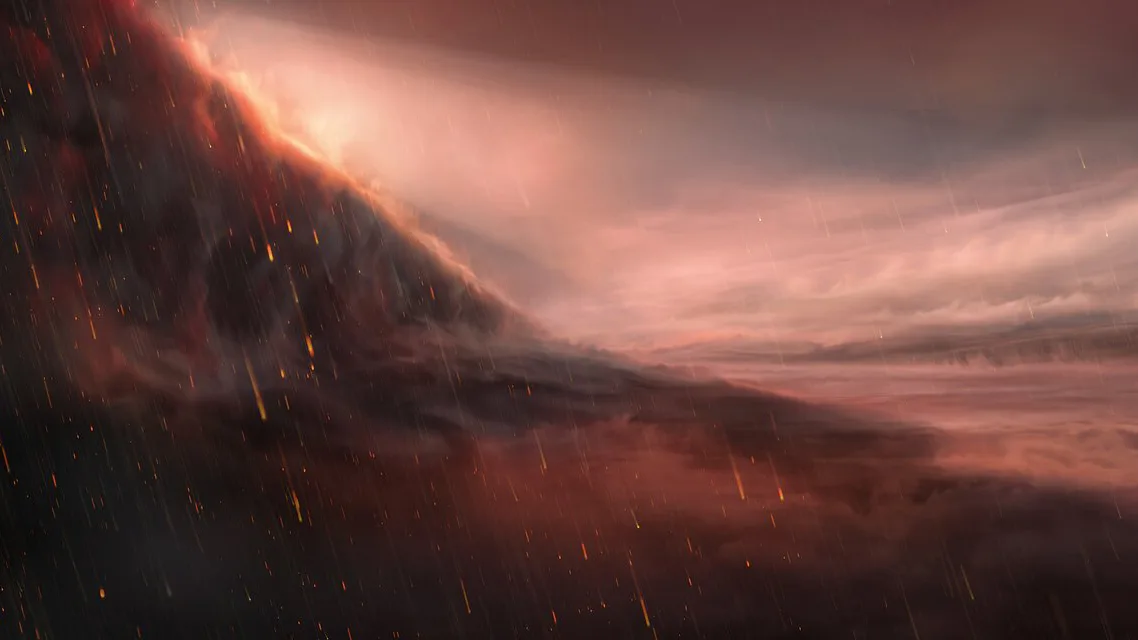
Exoplanet weather forecast: Cloudy with a chance of liquid iron rain
WASHINGTON - Scientists have detected an exotic planet in another solar system where the weather forecast is always dire - a 100 percent chance of the most outrageous rain imaginable, with droplets of scaldingly hot liquid iron.
The researchers said on Wednesday they used the planet-hunting ESPRESSO instrument on the European Southern Observatory's Very Large Telescope in Chile to observe a planet called WASP-76b located about 640 light years from Earth. It is nearly twice the size of Jupiter, our solar system's largest planet.
Planets discovered outside our solar system are called exoplanets, and WASP-76b is one of the most extreme in terms of climate and chemistry. It is a member of a family of exoplanets spotted in recent years called "ultra-hot" gas giants.
It resides outstandingly close to its parent star, which is almost twice as big as the sun. WASP-76b orbits at only three times the radius of that star, much closer than our solar system's innermost planet Mercury orbits the sun. The same side of WASP-76b always faces its star, much as the same side of our moon always faces Earth.

A night-side view of the ultra-hot giant exoplanet WASP-76b that has a day-side facing its host star where temperatures climb above 2400 degrees Celsius, high enough to vaporise metals, with strong winds then carrying iron vapour to the cooler night-side of the planet where it condenses into iron droplets, is seen in an illustration released by the European Southern Observatory (ESO) on March 11, 2020. To the left of the image, we see the evening border of the exoplanet, where it transitions from day to night. ESO/M. Kornmesser/Handout
WASP-76b receives 4,000 times the solar radiation that Earth gets from the sun, and its "dayside" is baked, broiled and barbecued, reaching 4,350 degrees Fahrenheit (2,400 degrees Celsius). This ferocious heat vaporizes metals present in the planet, with strong winds then carrying iron vapor to the planet's cooler night side where it condenses into liquid iron droplets.
Molten iron rain may be a unique feature of these "ultra-hot" exoplanets, according to University of Geneva astronomer David Ehrenreich, lead author of the study published in the journal Nature.
WASP-76b illustrates the exotic nature of some exoplanets and shows that much remains to be learned about alien planetary systems.
"The extreme atmospheric conditions met in WASP-76b and its siblings, other 'ultra-hot' gas giants, are not found anywhere in our solar system and would be very difficult to reproduce in a lab," Ehrenreich said. "Therefore, these exotic objects are unique laboratories to crash-test our climate models and understand the most extreme forms of atmospheric evolution."
"The 'zoo' of planetary systems is far beyond our expectations," added astrophysicist and study co-author Maria Rosa Zapatero Osorio of the Center for Astrobiology in Madrid, coordinator of the ESPRESSO science team.
WASP-76b appears to be the only planet orbiting its star. While its diameter of approximately 165,000 miles (266,000 km) is about 1.9 times bigger than Jupiter, WASP-76b is actually slightly less massive than Jupiter. This may be the result of perpetually being heated up by the star or never having the chance to cool down and shrink after the planet's formation because of its position so close to the star.
"In other words, it is very much puffed up," Ehrenreich said.
(Reporting by Will Dunham; Editing by Sandra Maler)










